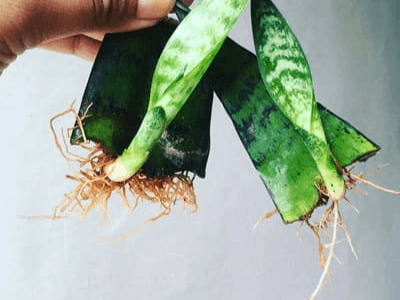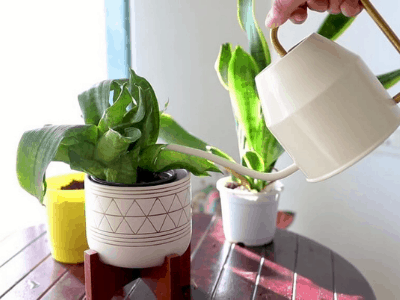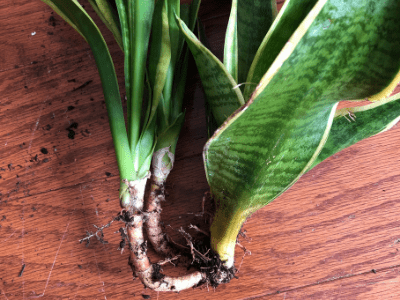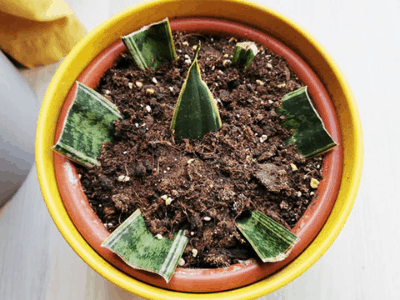Growing roots from dying snake plant?
It’s even silly the way it sounds, can you actually do it?
Hear it from Michaela!
I have had myself a dying snake plant…
I was so hopeless because the snake plant has been my number one companion…
… especially during this Covid times.
I tried several tips on the internet in how to revive it…
… sadly, it didn’t work for my case.
So what I did was take the leaves of my snake plant which still show signs of life…
… and then propagate it from there.
Well, it did work. But I was just not satisfied enough…
This experience had passed for me…
But is there any other way to bring back a dying snake plant?
Well there is!
Here, we will discuss about propagating our dying snake plant…
… from different propagation methods possible.
Watering And Root Structure

The root structure of the Sansevieria is one of the most important aspects to comprehend…
The root structure dictates a lot about basic plant care for most plants. Sans aren’t any different…
Snake Plant roots have very shallow rhizomes…
Usually grown in a very deep, 24 inch hole, tall grow pots with heavy soil…
… but the plant’s roots only go down about halfway or less into that deep pot.
The pot is more of a counterweight than anything else for the absence of ten grow pots…
… with a diameter of at least 12 inches and larger
Rhizomal roots grow outward rather than down deep…
Consider watering: if you water this plant thoroughly and then leave it standing in water…
… the standing water in the liner is unlikely to be used effectively.

In fact, it is not uncommon for a Sans watered in this manner to end up…
… with a nice stinky liner full of stagnant water.
It’s possible that in a situation with a lot of light and airflow, this method will work fine…
After all, there’s still some capillary action in the soil…
… that can wick that water up to where it belongs if the situation requires it.
The majority of indoor environments lack adequate lighting, airflow, and temperature…
When watering the Sansevieria indoors, the most important thing to remember is to be consistent…
- Consistency in application all around the soil surface to ensure that water is distributed evenly to the rhizomes throughout the pot.
- The frequency with which the water is applied should be consistent.
- Consistency in the balance of moisture content in the soil, not too wet, not too dry, and neither of these conditions can last for too long.
Apart from proper watering, Sans don’t require much in the way of routine maintenance…
It’s a good idea to wipe or dust their sword-like leaves from time to time…

… but because their leaves are vertical, they collect far less dust than most other houseplants.
Fungus gnats are the only pests that pose a threat to the plant…
… and they are usually a temporary problem that can be easily resolved with little to no damage to the plant.
Sans come in a variety of leaf structures; the more compact the leaf structure, the less water the plant will use…
However, if water is left in between the leaves, it may cause rot on really compact floret-like varieties…
To the best of your ability, water the soil surface…
Why Does My Snake Plant Have No Roots?
Simply put, if your snake plant doesn’t have roots…
… it’s most likely because they rotted away from overwatering.

Now for the more in-depth explanation…
Sansevieria trifasciata, or snake plant, has long, tall, pointed leaves that stand straight up. They certainly should…
The leaves of some snake plants are tipping over and appearing floppy, according to some indoor gardeners…
This will not affect all of the leaves, but it will affect a few of them…
There’s no denying that there’s a problem…
It’s also, for the most part, a sign of something more serious…
Your snake plant, you see, has rhizomes, which are underground stems…
… that can produce adventitious roots, shoots, and leaves.
The water you pour in the pot will be retained by the rhizomes, roots, and leaves of your snake plant…
I’m sure you can see where this is going…
We recently discussed the differences between watering a houseplant…
… with tap water and watering it with rainwater.
Because the latter contains more oxygen, soaking your indoor plant will not harm it…
However, ordinary tap water is devoid of oxygen…
When you water your snake plant too much, it drowns…
The snake plant has a reputation for being a hardy indoor plant, and this is true…
It may be able to withstand some mistreatment, but that does not mean it is a good idea to do so…
It’s one thing if it’s unintentional, but don’t test the snake plant’s limits, because it unquestionably does…
When there is too much water in the leaves, they can become mushy and fall over…
The roots will rot in a similar fashion. As a result, your snake plant has no roots…
You could have gotten a bum snake plant that was already in this bad shape…
Someone in your life may have given you their overwatered snake plant because they don’t have a green thumb…
You may notice that the leaf clump’s base has a lump but no roots if you have such a houseplant…
You could easily pull the leaves from the plant if you wanted to…
You’ll notice that they don’t have any roots attached to them…
The perplexing aspect of snake plant ownership is that your Sansevieria may appear to be fine even in this state…
As previously stated, a few leaves, but not all of them, may fall over…
This may give you the false impression that your indoor plant is in good health…
The fact that the leaves of your snake plant appear to be vibrant and healthy…
… only adds to your false sense of security. However, don’t be fooled.
You won’t see any roots growing out of the bottom of the leaves…
… if they are loose to the touch and can easily be pulled up out of the soil.
It’s clear at that point that you’re not dealing with a healthy snake plant…
Snake Plant Propagation
You might want to propagate your snake plant for a variety of reasons…
Use a sunburned leaf or a leaf that has grown too tall and bent or broken…
Perhaps you accidentally overwatered your Sansevieria, resulting in root rot…
If the damage isn’t too severe…
You may be able to save your plant by propagating the parts that are still viable…
You may simply want to change the overall appearance of your plant by removing a few leaves here and there…
Those leaves that would otherwise be discarded can be used to grow your houseplant collection…
… or as thoughtful gifts for friends and family.
Through Pre-Existing Leaves

When your snake plant reaches this stage, it’s pretty much dead…
After all, root rot has set in, and the roots have died as a result of a lack of oxygen…
It’s a miracle your houseplant is still alive; most plant species would perish…
This one can be attributed to the snake plant’s hardiness, as previously stated…
Is there any way to save your plant and get it to regrow, given that it appears to be in good shape?
You can certainly give it a shot. It’s possible to propagate newer…
… healthier snake plants from the leaves of your current rotted snake plant.
Easy Propagation Tips
Use healthy leaves, preferably those that aren’t too old, for the best results…
When I say “quickest,” I don’t mean “overnight”…
Cuttings of snake plants take a long time to root…
Be prepared to put your patience to the test…
People usually say it doesn’t work because they didn’t wait long enough…
Snake plants do not develop roots over night…
It’s critical to keep the leaf cuttings facing the same way they did on the plant…
They will not root if you accidentally turn them upside down…
On the bottom of the cuttings, cut a v-shape notch…
This increases the surface area available for roots to grow…
… as well as making it easier to remember which side is up and which end to place in the water or soil.
If you propagate a variegated Sansevieria with yellow leaf margins…
… new leaves will not have the variegated yellow edges.
The only way to maintain the variegation is to divide your plant…
Remove a clump of leaves with roots from the main plant and repot it in its own container…
In just water, snake plant cuttings grow roots and new leaves…
How To Care For And Grow Your Snake Plant
There are dozens of different varieties of Snake Plants (also known as sansevieria or Mother-in-Law’s Tongue)…
… but none are as beautiful (or as air-purifying!) as the Laurentii.
This incredibly hardy indoor plant is the ideal choice…
… for anyone looking for a low-maintenance but stylish addition to their home or office.
Learn about the many benefits of Snake Plants…
… as well as how to care for and grow this lovely indoor plant.
How To Maintain A Beautiful And Healthy Snake Plant
If you take care of your Snake Plant, it will literally take care of you!
The Snake Plant has numerous advantages…
… including the ability to release oxygen and purify the air we breathe.
According to NASA…
… the Sansevieria Laurentii variety is one of the best air-purifying houseplants…
… and it is particularly good at filtering out toxins such as formaldehyde and xylene.
In addition to basic photosynthesis that removes carbon dioxide and returns oxygen to air, plants can remove toxicants/impurities from air, soil and water in at least two ways. First, they can metabolize some toxic chemicals, releasing harmless by-products; secondly they can incorporate toxicants, such as heavy metals into plant tissues, thus sequestering them.
Kalpana A. Kulkarni and Madhukar S. Zambare in The Impact Study of Houseplants in Purification of Environment Using Wireless Sensor Network
It’s also a great nighttime plant because it converts carbon dioxide to oxygen…
Here are some simple tips for keeping your Snake Plant healthy and reaping its many benefits over time…
Pruning
Whether your Snake Plant is overgrown or has some damaged leaves that need to be removed…
… pruning is a simple process.
Simply cut off the stalks you want to remove at the base…
… as close to the soil as possible, with a sharp, clean blade.
You can also tug on the leaf and pull it out from the root if it’s drooping, dry, or otherwise on its way out…
If it’s time to leave, it’ll come out easily!
Cleaning
Place each leaf between two soft tissue cloths and wipe the tops clean…
… to reveal a healthy sheen (this also helps the plant absorb more light!).
Repotting

Houseplants grow at a much slower rate than wild plants…
This should be done every 2-3 years, depending on the size of your plant and the density of the roots…
… to provide fresh nutrients and encourage new growth.
- When to repot? Snake Plants have extremely strong roots, and when it’s time to repot, they’ll literally burst out of their pot.
- Pot sizing? If you want your plant to grow taller, use a nursery pot that is 2” larger in diameter than the current one. You can reuse the same pot and simply change the soil if you want your plant to stay at the same height. If this is the case, you may need to separate some of your Snake Plant’s stalks, as they will most likely no longer fit in the pot.
- How to repot? Spread newspaper on the floor, remove the plant from the pot, and shake off as much of the old soil as possible to ensure that the roots are clean. Place the plant in the pot’s center, then fill it with new soil and firmly pat it down. Thoroughly water the soil and place the plant in a bright, indirect light source. It will take 2-4 weeks for your plant to recover from the shock and adjust to its new surroundings.
To sum it up…
If you find your snake plant dying…
Don’t throw it away, you can still make use of it…
Just choose a propagation method available for snake plant…
… and try it on to have a brand new baby snake plant.
Conclusion
If you still have any doubts or questions on the matter…
Comment down below and let us know…
You can also contact us for personal engagements…
Check out more posts on our website like this one here!
Have an awesome gardening journey!

